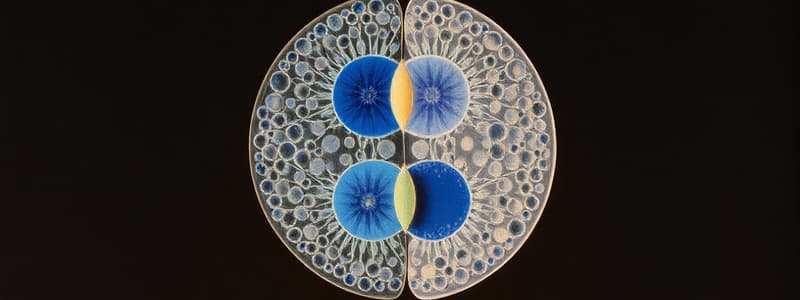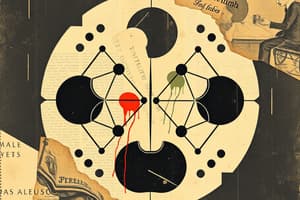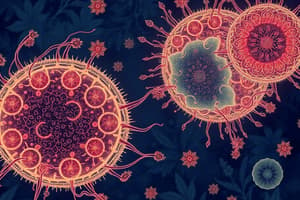Podcast
Questions and Answers
What is the main purpose of the cell cycle control system?
What is the main purpose of the cell cycle control system?
- To permanently halt cell division in all circumstances
- To regulate the order and progress of the cell cycle stages (correct)
- To amplify the effects of apoptosis in cells
- To ensure cells are produced continuously without any checks
Which checkpoint is primarily responsible for checking DNA integrity?
Which checkpoint is primarily responsible for checking DNA integrity?
- S phase checkpoint
- Mitotic stage checkpoint (M)
- G1 checkpoint (correct)
- G2 checkpoint
What role do external signals play in the cell cycle?
What role do external signals play in the cell cycle?
- They ensure that cells cease division immediately upon contact.
- They can stimulate or block progression through the cell cycle. (correct)
- They are ineffective in influencing internal processes.
- They only assist in preventing cell division.
What is the function of cyclins in the cell cycle?
What is the function of cyclins in the cell cycle?
What is the function of contact inhibition in cell division?
What is the function of contact inhibition in cell division?
What happens to chromosomes before mitosis?
What happens to chromosomes before mitosis?
During which phase of mitosis do chromatids separate and move towards opposite poles of the cell?
During which phase of mitosis do chromatids separate and move towards opposite poles of the cell?
What is the role of microtubules during mitosis?
What is the role of microtubules during mitosis?
What structure joins sister chromatids together?
What structure joins sister chromatids together?
How are daughter chromosomes formed during cell division?
How are daughter chromosomes formed during cell division?
Flashcards are hidden until you start studying
Study Notes
Cell Division
- During cell division, chromosomes duplicate to form two sister chromatids.
- Sister chromatids are joined at the centromere and contain identical DNA.
- Sister chromatids separate during cell division to become daughter chromosomes.
- Each human cell has 46 chromosomes.
- A karyotype is a visual representation of chromosomes arranged by size.
Mitosis
- Mitosis is a type of cell division that enables growth.
- Mitosis is traditionally divided into four phases: prophase, metaphase, anaphase, and telophase.
- During prophase, chromosomes become visible under the microscope.
- In metaphase, chromosomes align along the equatorial plate of the cell.
- Anaphase involves the separation of chromatids to opposite poles of the cell.
- Telophase and cytokinesis mark the formation of two distinct daughter cells.
Cell Cycle Control
- The cell cycle is controlled by a system that ensures proper order and completion of stages.
- G1 checkpoint verifies DNA integrity; if irreparable, apoptosis or G0 phase (no division) occurs.
- G2 checkpoint ensures DNA has been copied correctly.
- Mitotic stage checkpoint (M) occurs between metaphase and anaphase, ensuring chromosomes are attached to the microtubule spindle.
Signals and Cyclins
- Signals can stimulate or inhibit cell cycling.
- External signals include epidermal growth factor (EGF), platelet-derived growth factor (PDGF), estrogen, and contact inhibition.
- Internal signals include cyclins, proteins present only in specific cell cycle stages.
- Cyclins help cells transition to the next stage and are broken down in the following phase.
Apoptosis
- Apoptosis is programmed cell death triggered by internal or external signals.
- It helps maintain the correct number of cells and is a normal part of growth and development.
- Final cell fragments are engulfed by white blood cells.
Reproduction
- Single-celled organisms reproduce easily through processes like binary fission.
- Multicellular organisms produce gametes (sex cells).
- Female gametes (eggs) are produced in the ovaries.
- Male gametes (sperm) are produced in the testes.
Meiosis
- Meiosis reduces the chromosome number from diploid (2n) to haploid (n).
- Gametes have only one member of each homologous pair.
- Spermatogenesis produces sperm in the testes.
- Oogenesis produces eggs in the ovaries.
- Egg and sperm combine to form a diploid zygote.
Homologous Chromosomes
- Homologous chromosomes are paired chromosomes with the same size, shape, and genes for the same traits.
- Before meiosis, chromosomes duplicate to form two sister chromatids.
Meiosis I
- Homologous pairs line up at the center of the cell.
- Homologous chromosomes of each pair separate during anaphase I.
- Crossing-over involves the exchange of genetic material between non-sister chromatids of homologous chromosomes.
Variation and Natural Selection
- Variation generated through meiosis is crucial as the raw material for natural selection.
- Natural selection favors organisms with traits that enhance survival and reproduction.
Asexual Reproduction
- Some animals reproduce without meiosis and fertilization, known as parthenogenesis.
- Examples include certain species of whiptail lizards.
Benefits of Sexual Reproduction
- Sexual reproduction offers a long-term benefit of creating more variation, providing an advantage in changing environments.
- Some individuals may possess variations that allow them to survive environmental challenges.
Bacterial "Sex"
- Even bacteria exhibit gene transfer, a form of "sex" that is not meiosis.
- DNA is exchanged between two bacteria, leading to genetic diversity.
Studying That Suits You
Use AI to generate personalized quizzes and flashcards to suit your learning preferences.




